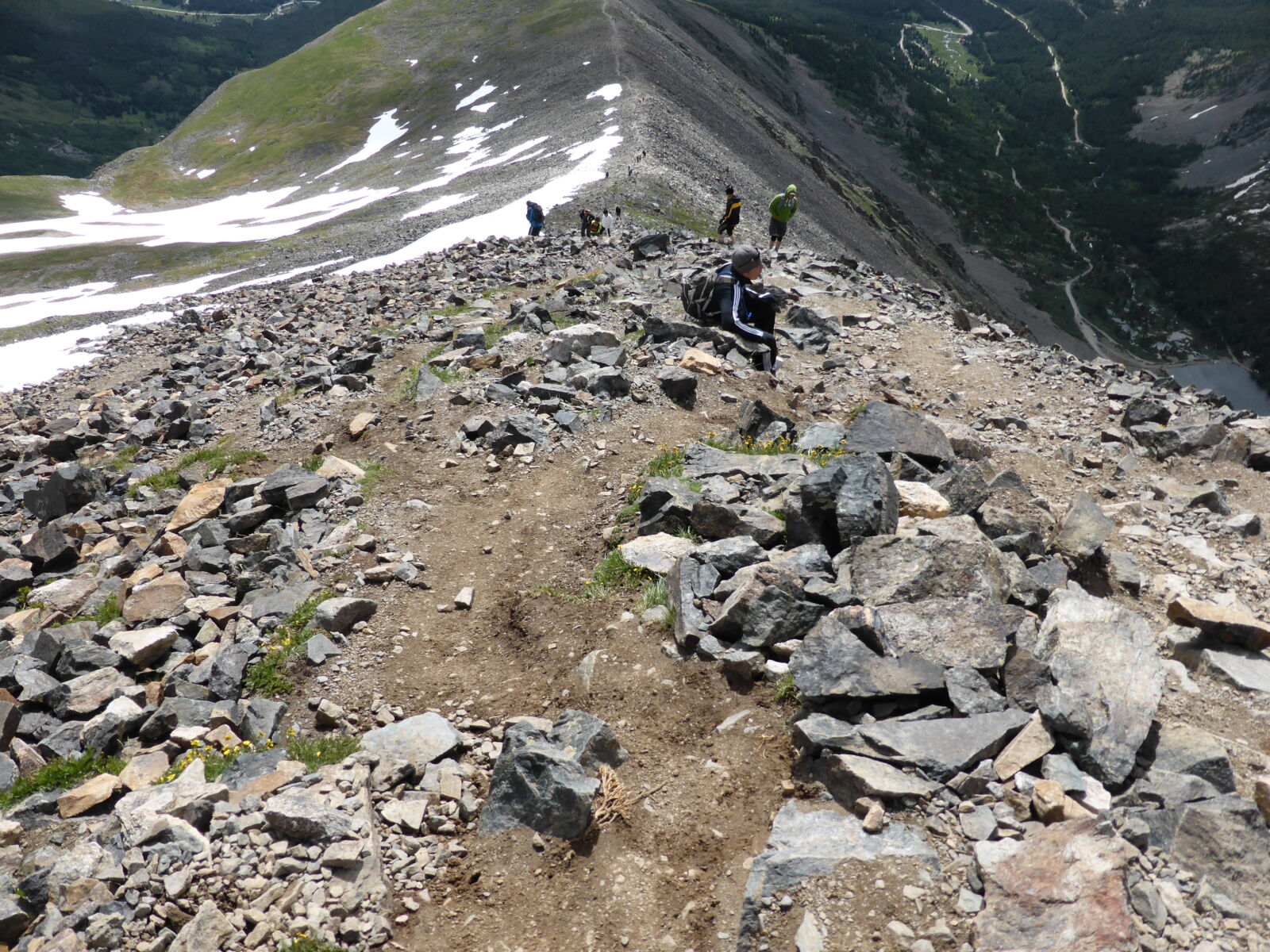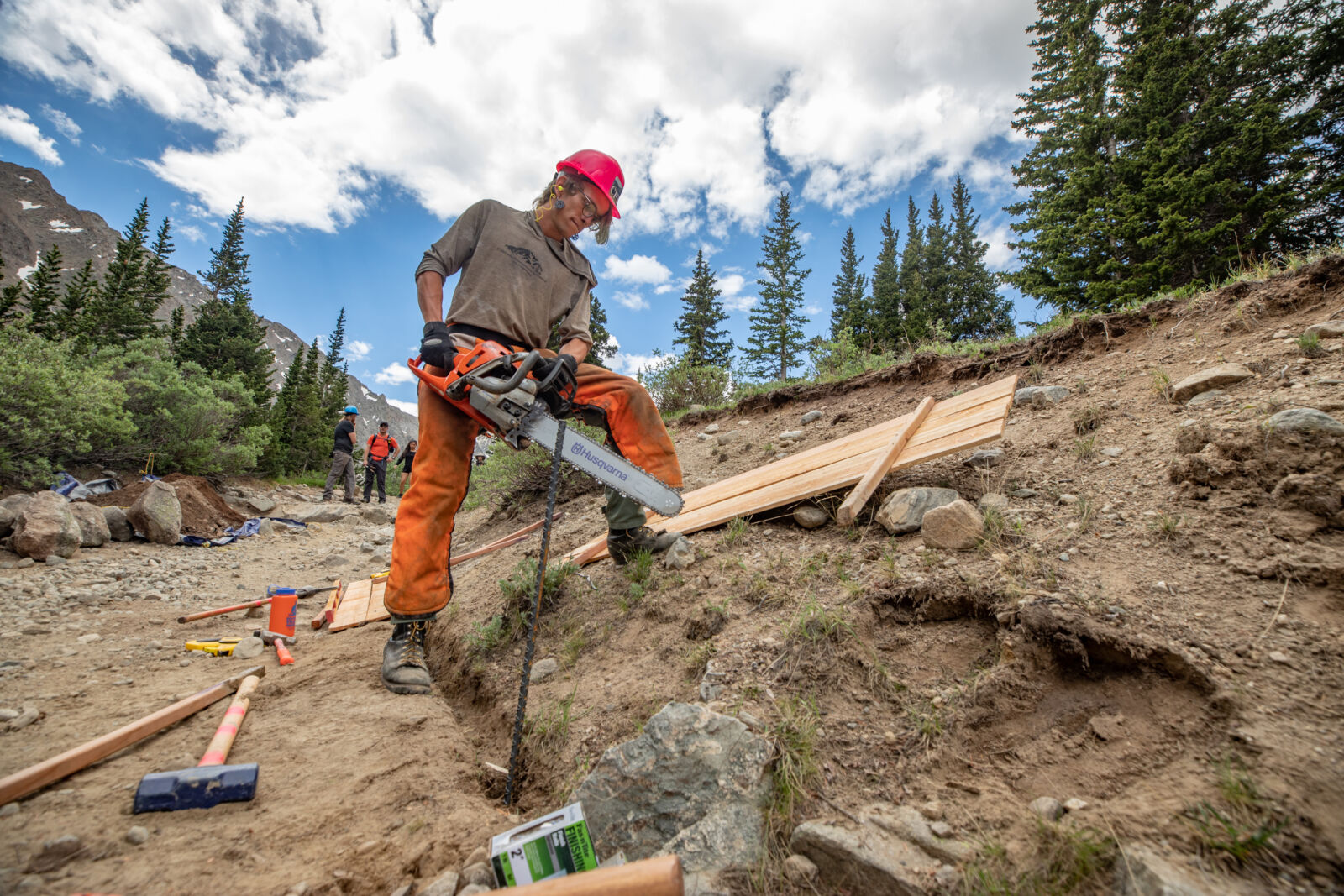Twenty years ago, you could kick back with a beer in Breckenridge, Colorado, and watch brightly-colored hikers trudging up the slope of Quandary Peak, striving for the mountain’s 14,265-foot summit. When the trail got muddy or snowy, as it often did, hikers stepped onto drier terrain.
Their footsteps killed the fragile plants that held the alpine tundra in place, increasing erosion and leaving corridors of dirt so wide they were visible from town, 10 miles away. People were inadvertently destroying the very landscape they’d come to see.
“We were losing big swaths of the mountain,” said Loretta McEllhiney, who manages the Colorado Fourteeners Program for the U.S. Forest Service. “There was so much damage.”
At the time, McEllhiney wasn’t yet in charge of managing Colorado’s fourteeners, as the state’s 54 peaks above 14,000 feet are called. She was a trail worker turned wilderness ranger who had moved to Colorado from Kansas and fallen for the high country. She loved the soaring views and the hidden nooks that pikas or ptarmigans called home. She loved how strong her body felt while swinging an ax. Most of all, she loved to get on her hands and knees and bury her nose in a patch of alpine forget-me-not, and then spend the rest of the day carrying the flowers’ heady scent on her skin. “I realized that this stark alpine landscape was anything but stark,” she said in a soft, measured voice. "It was teeming with wildlife.”
We were losing big swaths of the mountain.
McEllhiney wasn’t alone in her infatuation. So many people had begun climbing the fourteeners that the old trails—haphazardly created by hikers seeking the fastest route to the top—could no longer contain them. So, with Forest Service approval and input from trail users, scientists and nonprofit partners, McEllhiney began designing and building trails that concentrated people’s impact and avoided sensitive habitat. Several conservation groups were undertaking similar efforts, but alone, none could keep pace with visitor numbers, which have grown at a rate of roughly six percent per year. In 2015, the nonprofit Colorado Fourteeners Initiative assessed 43 of the peaks, issuing a “report card” and sustainability grade for each, from A to F. It rated nearly three-quarters at a C or below, and found that the trails needed $24 million in rehabilitation.
The report galvanized the National Forest Foundation to take action. In 2017, the NFF launched the Find Your Fourteener campaign, aimed at improving ecological health and trail conditions on the 48 Colorado fourteeners that fall on National Forest land.

Photo by Lloyd Athearn
Blown out trail on Quandary Peak.
“We brought outdoor groups and the Forest Service together to increase the pace and scale of trail restoration,” said Emily Olsen, the NFF’s program manager for Colorado.
To achieve that, the NFF identified bottlenecks that were slowing things down—a lack of manpower and money, for instance, or the fact that all trailbuilding gear was packed into the backcountry by one string of Forest Service mules. Then, the organization leveraged its networks and expertise to help solve these issues. Olsen and her team raised money from donors around the world, coordinated existing efforts by more than 10 local organizations, hired private pack strings to get more gear to remote base camps, provided support to extend the trail-building season, and hired professional trail planners to ease McEllhiney’s workload. They also helped get local communities more involved in protecting their backyard peaks, which was in turn vital to the FYF campaign.
“Without the collaboration and community connections, it wouldn’t be possible to complete the construction and restoration work at the scale envisioned,” Olsen said.
On Quandary Peak, you can already see a difference. By the time the NFF got involved, McEllhiney had already designed a new route for the trail and worked with professional and volunteer trail crews to move it, one painstaking foot at a time. But the new trail wasn’t well-defined, and hikers were still wandering off of it. So, the NFF partnered with organizations including the Rocky Mountain Youth Corps, Friends of the Dillon Ranger District, Volunteers for Outdoor Colorado, Wildlands Restoration Volunteers and the Colorado Fourteeners Initiative to improve the new trail. Hikers are now funneled onto a rocky ridge, where their footsteps won’t damage alpine plants or cause erosion. Also with FYF funding, crews restored and reseeded the old trails—an important step, since an inch of topsoil can take 1,000 years to form at this elevation.

Photo by Kellon Spencer
A trail crew member trims the trail side wall to stabilize the bank of the trail to Grays and Torreys Peaks.
When the Fourteeners Initiative issued its latest report card in 2019, progress was undeniable: Quandary Peak, once a C+, was given an A-. At the same time, the number of people scaling Quandary’s slopes has risen from roughly 14,900 hikers in summer 2014, to 40,300 in 2018, making it the most popular fourteener in Colorado. But because the new trail is designed so well, the increase in use hasn’t equated to more ecological damage. Today, you can no longer see hikers tramping over muddy, scarredland on Quandary from Breckenridge. Instead, you see an unbroken mountainside, with lush green meadow giving way to gray-brown rocks and the summit nudging the clouds.
Without the collaboration and community connections, it wouldn’t be possible to complete the construction and restoration work at the scale envisioned.
“Quandary defies the conventional wisdom that more people equals more impact,” said Lloyd Athearn, executive director of the Colorado Fourteeners Initiative. “If you can properly channel the use, you can protect the adjacent ecosystems while allowing people to have these incredible, life-changing experiences.”
That’s exactly what the NFF hopes to accomplish, not just on Quandary but across the state. The team plans to celebrate the completion of several more trails this summer, and get started on constructing and restoring others. Though there’s no definite end date, Olsen says she’ll know the work is done when the trails on Colorado’s fourteeners are more sustainable because of the campaign.
“I want to be able to say that we really moved the needle.”

